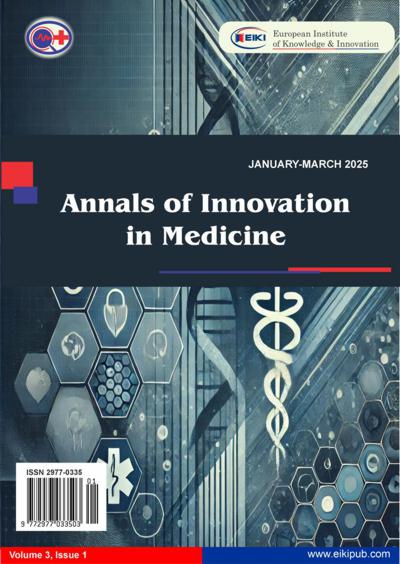Prevalence of Glucose-6-Phosphate Dehydrogenase in Children Attending Pediatric Clinic among Selected Hospitals in Abakaliki
Main Article Content
Abstract
Glucose-6-phosphate dehydrogenase deficiency is prevalent worldwide and common in malaria-endemic regions, affecting over 400 million people globally. G6PD deficiency compromises erythrocyte protection against oxidative stress, potentially leading to haemolysis. This study evaluated the prevalence of G6PD deficiency among children attending paediatric clinics in selected hospitals in Abakaliki, Ebonyi State, Nigeria. This cross-sectional study sampled 100 subjects aged less than one year to 13 years with equal gender representation. Venepuncture and standard laboratory practices were employed for blood sample collection from consented children falling within the specified age range. Brewer methaemoglobin reduction method and thin blood film analysis were conducted for investigation. Statistical analysis, were performed using the Statistical Package for Social Science version 26 to compare G6PD activities across age groups and genders. Results indicated varying deficiency rates across age groups, with the highest prevalence observed in the 2-4-year-old group (9%). Males exhibited a higher deficiency rate (12%) compared to females (7%), culminating in a 19% overall prevalence among paediatric clinic attendees. While significant differences in G6PD activity were found between males and females (p = 0.00), no significance was noted across age groups (p=0.29). The study emphasises the importance of G6PD screening in children given the relatively high prevalence observed in Abakaliki.
Downloads
Article Details

This work is licensed under a Creative Commons Attribution 4.0 International License.
References
Rostami-Far Z, Ghadiri K, Rostami-Far M, Shaveisi-Zadeh F, Amiri A, Rahimian Z. Glucose-6-phosphate dehydrogenase deficiency (G6PD) as a risk factor of male neonatal sepsis. J Med Life. 2016; 9(1): 34-38. PMID: 27974910.
Howes R, Piel N, Patil A, Nyangiri O, Gething P, Dewi M. Deficiency prevalence and estimates of affected populations in malar-ia-endemic countries: A geostatistical model-based map. PLoS Med. 2012; 9(3): e1001339. doi: 10.1371/journal.pmed.1001339.
Cappellini M, Fiorelli G. Glucose-6-phosphate dehydrogenase deficiency. Lancet. 2008; 371: 64-74. doi: 10.1016/S0140-6736(08)60073-2.
Akanni E, Oseni A, Agbona O, Tijani B, Tosan E, Fakunle E. Glucose-6-phosphate dehydrogenase deficiency in blood donors and jaundiced neonates in Osogbo, Nigeria. J Med Lab Diagn. 2010; 1(1): 1-4.
Sukumar S, Mukherjee M, Colah R, Mohanty D. Molecular basis of G6PD deficiency in India. Blood Cells Mol Dis. 2004; 33(2): 141-145. doi: 10.1016/j.bcmd.2004.05.001.
Al-Riyami A, Ebrahim G. Genetic blood disorders survey in the Sultanate of Oman. J Trop Pediatr. 2003; 49(1): 1-5. doi: 10.1093/tropej/49.1.1.
National Organization for Rare Disorders. Glucose-6-phosphate dehydrogenase deficiency [Internet]. 2022 [cited 2022]. Available from: (link unavailable).
Brewer G, Tarlov A, Alving A. Methaemoglobin reduction test. Bull World Health Organ. 1960; 22(6): 633-640. PMID: 13741124.
Cheesbrough, M. (2004). District laboratory practice in tropical countries, Part 2.
Isaac I, Mainasara A, Erhabor O, Omojuyigbe S, Dallatu M, Bilbis L. Glucose-6-phosphate dehydrogenase deficiency among children attending the Emergency Paediatric Unit of Usmanu Danfodiyo University Teaching Hospital, Sokoto, Nigeria. Int J Gen Med. 2013; 6: 557-562. doi: 10.2147/IJGM.S43757.
Olatundun W, Daniel G, Grace E, Brearley A, Slusher T, Troy C. Glucose-6-phosphate dehydrogenase deficiency in Nigerian children. PLoS One. 2013; 8(12): e68800. doi: 10.1371/journal.pone.0068800.
Piel F, Patil A, Howes R, Nyangiri O, Gething P, Dewi M, Hay S. Global distribution of the G6PD deficiency: G6PD deficiency prevalence. Blood. 2012; 120(23): 4518-4525. doi: 10.1182/blood-2012-07-444433.
DePina AJ, Pires CM, Andrade AJ, Dia AK, Moreira AL, Ferreira M, et al. The prevalence of glucose-6-phosphate dehydrogenase deficiency in the Cape Verdean population in the context of malaria elimination. PLoS One. 2020; 15(3): e0229574. doi: 10.1371/journal.pone.0229574.
Gallagher P. Anemia in the pediatric patient. Blood. 2022; 140(6): 571-593. doi: 10.1182/blood.2022010730.
Richardson S, O'Malley G. Glucose-6-phosphate dehydrogenase deficiency. StatPearls [Internet]. 2022 [cited 2022]. Available from: (link unavailable).
Jidda M, Ibrahim K, Aiki G, Abdullahi N, Abubakar B, Asiya U, et al. The prevalence of glucose-6-phosphate dehydrogenase (G6PD) deficiency in students of Sultan Abdurrahman School of Health Technology Gwadabawa, Sokoto, North-Western Nigeria. Int Blood Res Rev. 2017; 7: 1-6. doi: 10.9734/IBRR/2017/31901.
Lauden S, Chongwain S, Achidi A, Helm E, Cusick S, Krug A, et al. Prevalence of glucose-6-phosphate dehydrogenase deficiency in Cameroonian blood donors. BMC Res Notes. 2019; 12(1): 195. doi: 10.1186/s13104-019-4267-5.
Albagshi M, Alomran S, Sloma S, Albagshi M, Alsuweel A, AlKhalaf H. Prevalence of glucose-6-phosphate dehydrogenase deficiency among children in Eastern Saudi Arabia. Cureus. 2020; 12(10): e11235. doi: 10.7759/cureus.11235.
World Health Organization. Global malaria programme malaria policy advisory group. Meeting report of the technical consultation to review the classification of glucose-6-phosphate dehydrogenase (G6PD) deficiency. Geneva, Switzerland: World Health Organi-zation; 2022.

